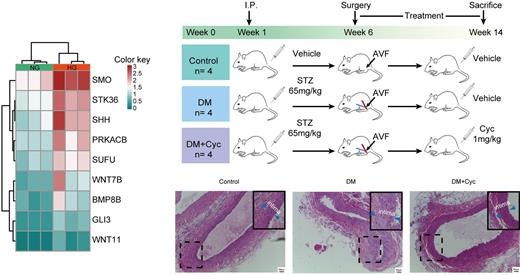Abstract
Abstract: When patients with diabetic factors undergo hemodialysis with an arteriovenous fistula (AVF), the fistula is prone to stenosis with unclear mechanism. As a dynamic barrier between the blood and the vessel wall, the endothelium is easily damaged by molecules in the blood, and the mechanism between its dysfunction and the pathogenesis of AVF is still unclear. In this study, we aimed to investigate the mechanism of endothelial dysfunction, and the interventions of endothelial function to rescue of AVF stenosis. We investigated the release of inflammatory cytokine TNF-α from endothelial cells during AVF stenosis in Diabetes Mellitus, the mechanism of endothelial dysfunction, and the improvement of endothelial cell function to rescue of AVF stenosis after the implementation of interventions in clinical collected data, animal models, and cell-based studies. Our study finds high glucose stimulation could induce inflammatory cytokine TNF-α overproduction and dysfunction of endothelial cells. SMO expression was upregulated in high glucose stimulated endothelial cells, indicating activation of hedgehog signaling. Inhibition of SMO expression either by genetically knockdown or with its inhibitor Cyclopamine (Cyc) efficiently reduced the release of TNF-α and partially reverted the endothelial dysfunction in vitro and in vivo. GLI1 was further confirmed to be a downstream effector of SMO to induce the expression of TNF-α, and its inhibitor could block this effect. This study provides a new perspective that SMO-GLI1 axis as a promising therapeutic target for reducing the release of inflammatory cytokine TNF-α and alleviating endothelial cell dysfunction to prevent AVF stenosis in diabetic patients.
Keywords: arteriovenous fistula stenosis; endothelial cell dysfunction; hedgehog signaling pathway; high glucose; inflammatory cytokine.
Disclosures: No relevant conflicts of interest to declare.
Disclosures
No relevant conflicts of interest to declare.
Author notes
Asterisk with author names denotes non-ASH members.


This feature is available to Subscribers Only
Sign In or Create an Account Close Modal